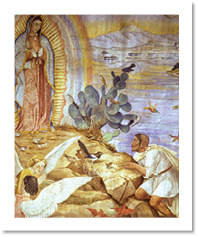The Story of Our Lady of Guadalupe

In 1519, the Spaniard Hernan Cortes arrived in Aztec Mexico with his small band of soldiers. By 1521, Cortes and his local allies had defeated the Aztec Empire and added the Yucatan Peninsular to the colony of New Spain. In 1524, twelve Franciscans arrived in the new territory to begin evangelising the native peoples. They learned as much as they could about their new people, but many of the other Spaniards were cruel conquerors, decimated by plague and the destruction of their culture, the native people wanted nothing to do with the pale man that Spaniards said was God.
Twenty kilometres north of Tenochtitlan (Modern Mexico City), they were welcomed by a middle-aged man named Cuauhtlatoatzin and his wife. Cuauhtlatoatzin was a simple peasant man who converted to Christianity with his wife, taking the names Juan Diego and Maria Lucia. Juan Diego, his wife and elderly uncle, Juan Bernardino, were among the few natives to convert. Maria Lucia became ill and died in 1529, a few years after their conversion.
 As a widower, Juan Diego would walk every Saturday and Sunday to Church for mass and catechesis. Saturday December 9, 1531, Juan Diego was taking his usual route past the Tepeyac hill when he heard birds singing and a lovely voice calling his name. When he ran to the top of the hill and came across a beautiful young lady. She was dressed as an Aztec princess and surrounded by light. She spoke to him affectionately in his native Nahutal language.
As a widower, Juan Diego would walk every Saturday and Sunday to Church for mass and catechesis. Saturday December 9, 1531, Juan Diego was taking his usual route past the Tepeyac hill when he heard birds singing and a lovely voice calling his name. When he ran to the top of the hill and came across a beautiful young lady. She was dressed as an Aztec princess and surrounded by light. She spoke to him affectionately in his native Nahutal language.
The Lady asked Juan Diego to go to the Bishop and build a shrine on this hill. Juan Diego went immediately to the Bishop, Juan de Zumárraga and told him what he had seen. The Bishop was sceptical of the story and dismissed Juan Diego. He returned to the Lady and begged her to send someone else, someone more important than him. She told him that he was the perfect messenger and bade him to try again on Sunday. Juan Diego obeyed and returned to the bishop. Bishop Juan was still sceptical and asked for a sign to prove that it was indeed Mary.
Juan Diego returned to the Lady and told her about the sign the Bishop asked for. She asked Juan Diego to return to her the next day and she would give him a sign to take to the Bishop. Juan Diego returned home to discover that his uncle was extremely sick. The following morning Juan Diego left to go and fetch a priest to administer last rites. He avoided the Tepayac hill, hoping to slip past.
The Lady met him on the road at the foot of the hill. He told her about his uncle and promised to attend to her request after taking care him. The Lady assured him that she would see that his uncle is healed and sent him to the top of the hill to collect flowers. It was a cold winter morning and to his surprise, he found a garden of blooming Spanish roses. He gathered as many flowers as he could in his tilma and brought them back to the Lady. She rearranged the flowers and bade him to go to the Bishop and show no one but the bishop himself. Upon arriving at the Bishop’s house, Juan Diego was made to wait, and wait. Some attendants of the Bishop were constantly badgering Juan Diego, asking him to show them what was in his cloak. Juan Diego opened his cloak a little and they ran to tell the Bishop.
Juan Diego was quickly brought to the Bishop and when he arrived in the room he opened his tilma and out tumbled red Spanish roses. To his surprise, everyone in the room fell down on their knees with the bishop begging forgiveness for doubting. Juan Diego looked down at his tilma and imprinted was the perfect likeness of the Lady.
Bishop Juan immediately began organising for a shrine to be built on top of the Tepayac hill and Juan Diego returned home to discover his uncle alive and well, having been visited by the Lady who told him her name, The Perfect Virgin, Saint Mary of Guadalupe. Juan Diego was given guardianship of the Image which he placed in the new shrine. He lived nearby as a hermit and caretaker of the Shrine until his death in in 1548.
News spread quickly about the miracle and within ten years, all 8 million native Mexicans were baptised and received into the Church which on average, equals 3000 people every day for 10 years. Our Lady of Guadalupe became the symbol of Mexico and has galvanised and brought together people from all over the world to live and believe in her son.
Author: Kiara Pirola
References:
Carl Anderson, Our Lady of Guadalupe: Mother of the Civilisation of Love, Double Day, New York, 2009.
‘Am I not your Mother? Our Lady of Guadalupe’, maryourmother.net

